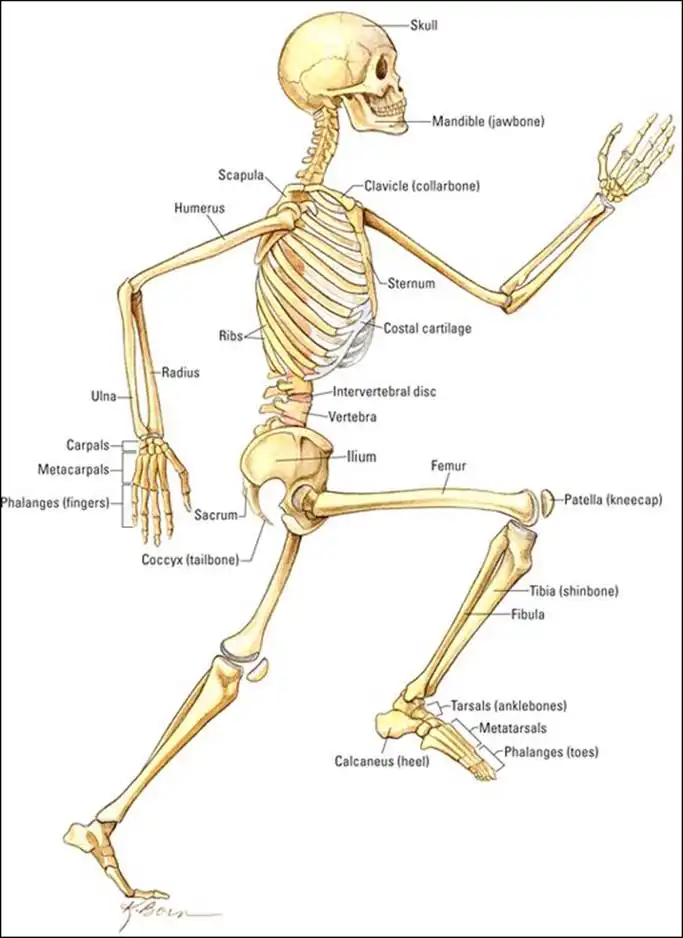Listing the functions of your skeleton
If you have any skeletons in your closet, now is the time to pull them out. We’re not talking about your deep, dark secrets. Seriously! Actually looking at a model of a skeleton is the best way to figure out what’s connected to what. If you don’t have any skeletons in your closet, try your refrigerator. Observantly cutting up a chicken can show you a lot about bones and joints. And you’ll get a head start on dinner!
The skeleton determines humans’ general shape and size as a species, and also humans’ very distinctive upright posture and bipedal gait. To get an overview of the skeleton, refer to the "Major Bones of the Skeleton" color plate in the center of this book.
In humans, as in all vertebrates, the skeleton is part of the musculoskeletal system. The other part, the muscular system, is the subject of Chapter 6.
The skeleton consists of all your bones, all the joints that connect your bones, and various kinds of fibrous tissue that cover, protect, and bind bones and joints together. In this chapter, we look at the special structures of these tissues and name some of the most important bones and joints. Other important functions of bone tissue, like mineral storage and blood cell production, are mentioned briefly or covered in detail in other chapters.
Reporting for duty: the jobs of your skeleton
The structural functions of the skeletal system are these:
- Protection: Bones and joints are strong and resilient. The rib cage provides a protected inner space for your more delicate internal organs. The vertebral column partially encases and protects the spinal cord, and the skull completely encases the brain.
- Movement: The musculoskeletal system is a motion machine: The bones anchor the skeletal muscles and act as levers, the joints act as fulcrums, and muscle contraction provides the force for movement. (See Chapter 6 for information about muscles and muscle contraction.)
- Support: The curved vertebral column supports most of your body’s weight (see the section "Setting you straight on the curved spinal column" later in the chapter). The arches of your feet support the weight of your body in a different way (see the sidebar "Strong feet, firm foundation").
See also
- Locating Physiology on the Web of Knowledge
- Chapter 1. Anatomy and Physiology: The Big Picture
- Chapter 2. What Your Body Does All Day
- Chapter 3. A Bit about Cell Biology
- Sizing Up the Structural Layers
- Chapter 4. Getting the Skinny on Skin, Hair, and Nails
- Chapter 5. Scrutinizing the Skeletal System
- Chapter 6. Muscles: Setting You in Motion
- Talking to Yourself
- Chapter 7. The Nervous System: Your Body’s Circuit Board
- Chapter 8. The Endocrine System: Releasing Chemical Messages
- Exploring the Inner Workings of the Body
- Chapter 9. The Cardiovascular System: Getting Your Blood Pumping
- Chapter 10. The Respiratory System: Breathing Life into Your Body
- Chapter 11. The Digestive System: Beginning the Breakdown
- Chapter 12. The Urinary System: Cleaning Up the Act
- Chapter 13. The Lymphatic System: Living in a Microbe Jungle
- Life’s Rich Pageant: Reproduction and Development
- Chapter 14. The Reproductive System
- Chapter 15. Change and Development over the Life Span
- The Part of Tens
- Chapter 16. Ten (Or So) Chemistry Concepts Related to Anatomy and Physiology
- Chapter 17. Ten Phabulous Physiology Phacts
- Supplemental Images

